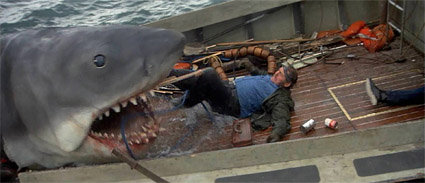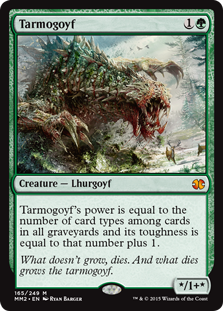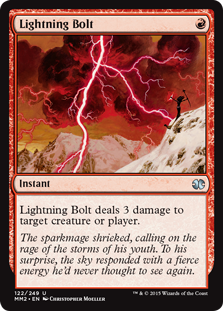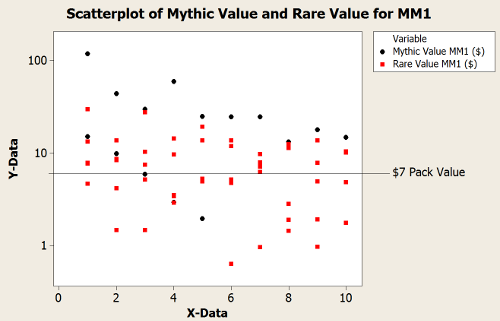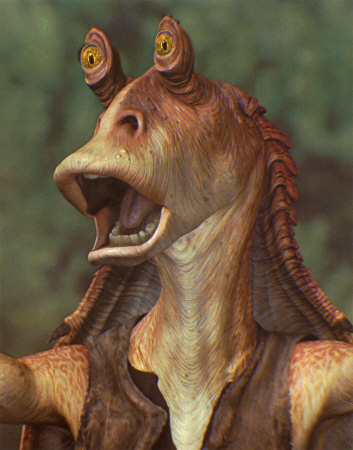Problem #2: It Has A Weaker Supporting Cast
Like a solid plot evolving from its origins, casting is a huge component to a sequel’s success. Sometimes you can run into cases where the vast majority of the cast returns and the results are still terrible (we’re looking at you The Exorcist II). More commonly though, most bad sequels shuffle too much of the cast, whether that’s not having some of the main cast return, or the primary character(s) do but the entire supporting cast has been swapped with subpar replacements.
Take the classic and iconic movie Jaws. This fairly low-budget film about a giant shark terrorizing a New England coastline earned numerous award nominations, catapulted Spielberg into fame, and swam into the annals of cinematic history. It resonated because it struck the right emotional chord, it had a cohesive plot, and it had a decent cast.
Then they went and made Jaws 2, which not only rehashed nearly the exact same plot and trivialized the heroism and sacrifices people went through in the first movie, but so few people returned from the first movie that you could feel the plummet in quality. Even lead actor Roy Scheider didn’t want to be part of it, but he was forced to because he was under contract with the studio.
The failure of Jaws 2, like many sequels, is that it simply became a vehicle for the main character to be on screen and drum up sales. In this case it was a giant man-eating shark. With Modern Masters 2015, it’s Tarmogoyf and his pricey friends.
The single biggest complaint most have with the second Modern Masters is its monetary valuations. The value of the cards in the set on the whole aren’t nearly as good of an investment this time around, which has led to some cynical observations that the set serves mostly as a reprint machine for Vendilion Clique, Tarmogoyf, and Dark Confidant.
Those views aren’t inherently wrong.
An excellent article was done over on MTGGoldfish that dissected the card value breakdowns incredibly well, and the entire thing is worth a read. However, the gist is that if you open a mythic in your pack (besides the comically out-of-place Comet Storm), you totally get your money’s worth for that pack’s cost. Beyond that, your chances of getting value for your purchase drops substantially:
Unlike the mythics which are pretty much all valuable, there are only 10 Rares that can really be considered winners either paying for the pack, or at least coming close enough that you can break even with a decent foil or uncommon. This ratio actually isn’t that bad. The bigger problem is the lack of mid-tier rares. There are only six rares in the $3 through $7 range, and all of these are much closer to $3 than to $7.
This means that 20 percent of the time you’ll open something sweet, 10 percent of the time you’ll open something middling, and 70 percent of the time you’ll open a rare worth $2 or less. For every Noble Hierarch you’ll open four Long-Forgotten Gohei. Compare this to the original Modern Masters, which had 17 rares in the “more than a pack” category (32 percent), another 14 in the $3 through $5 range (26 percent), and about 40 percent in the bulk range. This is a stark and significant difference.
And this is not to mention the high number of literal bulk rares. In researching this article I stumbled across the fact that Modern Masters 2015, a set that has a MSRP of $10 per pack (2.5 times the cost of a “regular” pack), has more bulk rares than Dragons of Tarkir. And it was only a couple months back I was writing about how DTK had an absurdly low EV during the prerelease period.
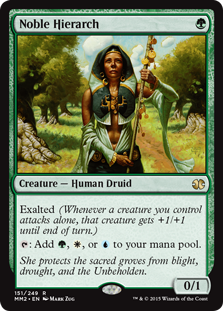
There’s no way this should be a $40 card anyhow.
Ergo, if you pull a decent foil rare or a mythic, it helps justify the cost. Most of the time, though, you are going to lose money on this set. Compared with the previous Modern Masters, that is a huge deviation. Sure, this set has a number of high end reprints like the Hierarch and Spellskite, but it also has an awful lot of rares that do not come close to being a fair deal for the cost of the pack, let alone a draft.
This says nothing of the absolutely abysmal uncommon pool. Aside from Remand, there are almost no highly sought after uncommons in this set. This is an even starker contrast from the previous set where many uncommons printed were going for the same price as many of the lower to middle range rares. Hell, in the first one, there were commons that had value to them. In many ways, uncommons are the true supporting cast of any set though, and when it comes to a cost benefit ratio, Modern Masters 2015 went with a bunch of C-list actors.
The cost of packs only compound this problem. The last Modern Masters packs had an MSRP $3 cheaper than this time around. Yet since most stores were charging $10-12 each, they were making a nice profit off it. Well, Wizards decided to shift that cash back towards themselves by making MM2 a $10 per pack MSRP, which rightfully or not, is highly perceived as nothing more than a stopgap measure at best and a pure money grab at worst. On the one hand, this shift made it much harder for stores to price gouge their customers with extravagant prices. On the other hand, it means Wizards reaps more of the profit, and stores that adhered to $7 last time (they did exist) are forced to price part of their clientele out of a product with this set.
Most importantly, this increased price tag adds that much more of a barrier to entry for players new to the Modern format since it was already deemed an expensive endeavor the last time around. But this increase makes it almost $10 more expensive to draft (at a minimum) and $3 more for a pack, creating a very real effect of pushing casual players away from it entirely. Modern Masters 1 at least had the veneer of giving casual players a luxury item to purchase, but MM2 seems intent on avoiding that.
With more expensive packs having less overall worthwhile cards, Modern Masters 2015 is not nearly as cash-friendly as its predecessor. There seems to be two possibilities for Wizards doing this, both driven by their terrifying fear of the Chronicles Effect. Firstly, since they were worried about the possibility of ‘flooding the market with too many good cards’, Wizards opted to stratify the set by containing fewer cards of financial worth at the lower ends of the spectrum in exchange for increased production.
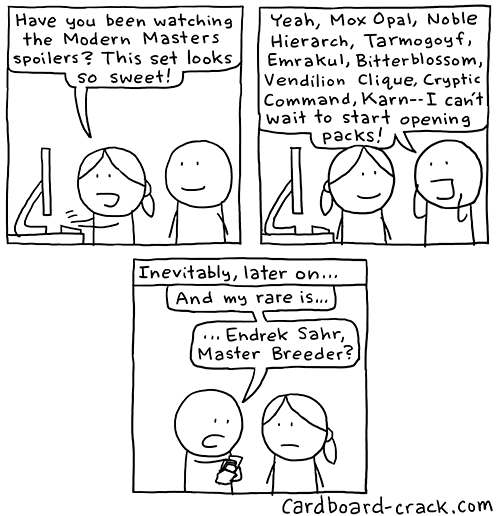 It’s widely known that the first Modern Masters had a conservative print run because of the fear that too many powerful, popular, and valuable reprints would be disruptive on the market. In that sense, they were partially successful: while the prices of ‘bulk’ and medium-valued rares of the first set did drop over time, the value of the top-tier rares and mythics stayed flat for a while before going up. This is simple supply and demand again at work.
It’s widely known that the first Modern Masters had a conservative print run because of the fear that too many powerful, popular, and valuable reprints would be disruptive on the market. In that sense, they were partially successful: while the prices of ‘bulk’ and medium-valued rares of the first set did drop over time, the value of the top-tier rares and mythics stayed flat for a while before going up. This is simple supply and demand again at work.
Say I made 100 of the most amazing toy cars. They look cool, they’re fun to play with, and they’re really solid quality. And I then sell them for $1 each, stating that it was unlikely I would ever make more of them. In time, people continued to buy and sell those toy cars on their own, and the market price steadily climbed. Many people became willing to pay $20 for a $1 toy car. For those with the money or the driving need to have those cars, they were willing to pay that premium. For the average person, though, it proved too hard to justify spending more than a couple dollars above what those mere toys originally went for. As a result, most consumers stop trying to buy them, consigning themselves to the reality that those cars are not something they’ll attain at a reasonable rate.
Then, say, I go and announce that I’ll be releasing another set of toy cars. Only this time I’m making just 20 of them, and I’ve raised the price to $5 each. Those who were willing to pay $20 are beyond excited – but so are some of the people who only wanted to spend $1. $5 is far more reasonable than $20 after all, and so they once again hop into the ring to try to snag one. For a brief time, it’s possible to get them affordably, before the market quickly reasserts itself. As a result of a new limited supply far outstripping renewed demand (which was never adequately met the first time around), those with the more disposable budgets started to trade them at $30 instead. As a producer, I don’t care because I’m only adding a small percentage of my awesome toy cars to the market, keeping them a valuable commodity. And I still made my $100.
This is exactly what happened with the first Modern Masters. Many Modern and Modern-to-be tournament players initially were priced out of the chance at getting top-tier cards for the format, but MM1 gave the prospect of easier access to Goyf, Bob, and friends. Existing tournament players saw it as a way of saving money, whereas some players on the tourney sidelines saw it as their chance to finally get in on the action. The problem was, the supply of the first Modern Masters wasn’t nearly enough to meet the demand of the existing Modern base plus newcomers. As a result, the price of these marquee cards has actually increased. Tarmogoyf, for example, has risen almost 50% since Modern Masters 1 – completely antithetical to advertised premise of what the set was supposed to do.
Way to go Wizards. You failed at basic economics. And to some extent, you did it on purpose.
To be fair, even Wizards came out after the fact and admitted that the highly limited run was a mistake. But their concerns about flooding the market didn’t dissipate. Thus, when Modern Masters 2015 was decided upon, they needed to make a tough decision. The knew that they had to make a larger print run than they did previously, but with that looming fear of negatively impacting the secondary market (you know, the one they repeatedly can’t publicly acknowledge the existence of), they took two important steps.
The first was the aforementioned reduction of medium to upper tier valued cards represented in the set. Just like the previous Modern Masters, this is a 249 card set that breaks down along normal set distribution: 101 commons, 80 uncommons, 53 rares, and 15 mythic rares, all in 15 card booster packs. And just like last time, each pack contained a foil instead of a basic land. The only change was the inclusion of 20 more uncommons, which increased diversity but also diffused the overall number of times a given uncommon would be seen.
This increase in uncommons coincides with the conspicuous absence of a lot of valuable uncommons and medium-valued rares, since Wizards is aware that if they print more than the current demand level for them, prices will drop. Once the need for Splinter Twins, Blinkmoth Nexuses and Daybreak Coronets are saturated in the Modern format, the price will inevitably start to come down…at least for a while. It’s already started with Remand – the only uncommon in MM2 that’s worth more than the ink it was printed on.
Secondly, they increased the MSRP of the box. The logic here seemed to be that aside from getting more money, the added cost would help deter just enough of the player base to keep pace with interest in the set. Remember: MM2 is considered a premium product, which means contrary to people’s interest in it, Wizards doesn’t intend it for every Magic player. And there seems to have been a deliberate effort to price some non-tournament people out of buying it.
In short, the theory seems to hold that Modern Masters 2015 purposely put less valuable cards in the set overall because they’d be printing more of them. They were fine with the selected mythics and chase rares, because helping to stabilize the cost of the format is within their best interest, they drive up interest, and the extra volume of those upper echelon cards should actually help mitigate card inflation of those two dozen cards for a bit. In a few cases, the price should even dip. For the rest of the cards, though, there will inevitably be notable price drops as cards begin to circulate. Therefore, they couldn’t have the set be crammed full of cool and marginally pricey cards; too many cards would be in flux at one time, which would certainly not amuse stores and collectors.
Essentially, outside of their pool of mythics, Modern Masters 2015 pulled their punches when it came to this print run. Granted, besides core sets – which served a different purpose – this is only the second attempt since Chronicles for a real anthology set. And whereas Chronicles printed too many, Modern Masters printed too few. MM2 was an experiment to see what a printing range in between would do. By putting a lower percentage of sought-after cards into the set, it allows them to be riskier on print volume. If the set proves still too restrictive, they always have the ability to reprint them yet again, and if volume proves too much, there won’t be nearly as many notable casualties in their overreach.
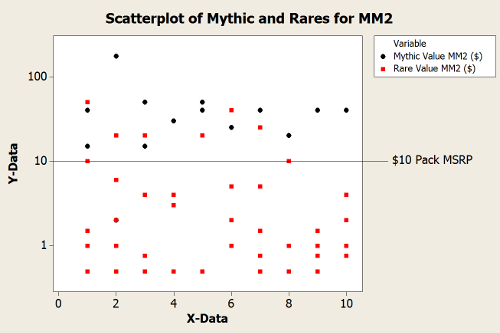
Spot the difference? The mythics are about the same since MM1, but for overall worth, everything else took a dive.
From a financial standpoint, doing so was a secure bet. But from a consumer’s perspective, where you’re trying to gets as much value for your money, them playing it safe has turned out to be very disillusioning. Due to the decrease in the overall value of the set, increased sticker price, and diluted strategic options, there is far less incentive for all but the hard-core tournament players to draft this more than once, if at all. For many casual players, the higher price tag alone is enough to justifiably turn them away.
Case in point: with the first Modern Masters, you had a 50% chance of opening packs that were worth more than their MSRP value. With MM2, the majority of the time you’ll open a pack that is worth 66% less than MSRP. Sure, cracking random packs in general nets you less than what you pay for them, but averaging $1-3 worth of cards for a $10 pack is egregious and outrageous from a consumer standpoint.
With too few notable cast members and the emotional substance they brought to the first flick, a poorly staffed movie sequel either winds up something that will be profitable but will suck (see Star Wars Episodes I-III), or its lack of talent and concerted desire to improve on the original’s story will create a become a box office bomb that should never have been made in the first place – like Caddyshack II.
Yet for all of our grousing and complaining, there’s little doubt that this set will be hailed as a huge success from a sales perspective. As such, Modern Masters 2015 is firmly in the same camp as Jar-Jar Binks. And no one wants that.
Back to Plot Issues or Onward to Poor Post Production

